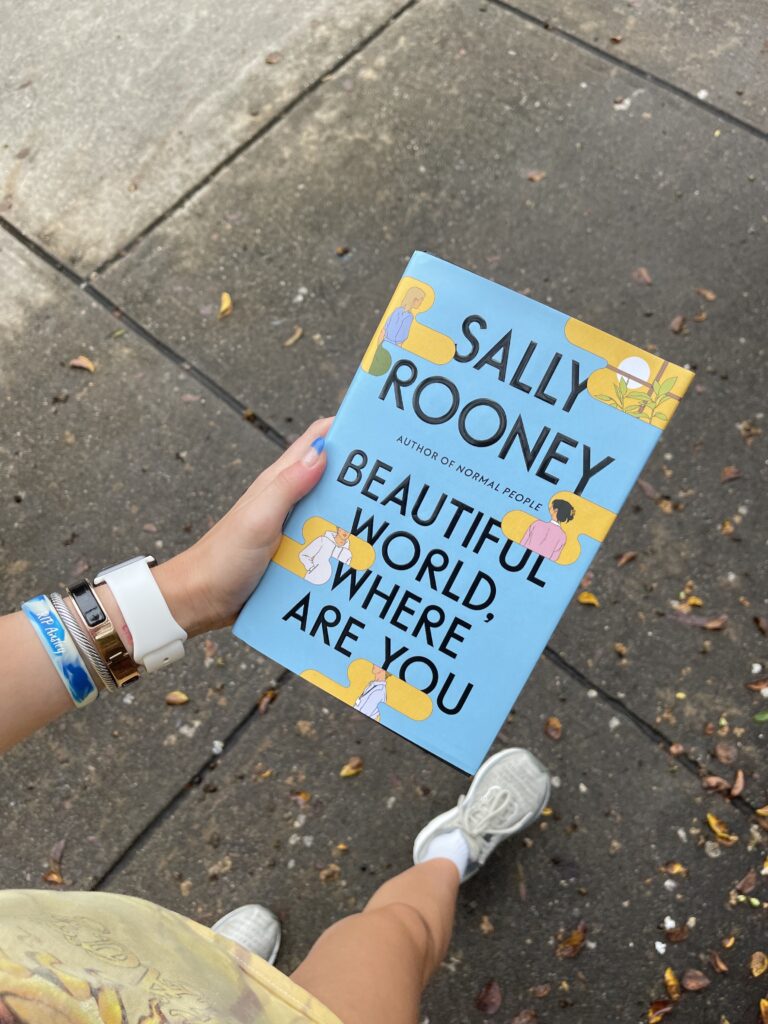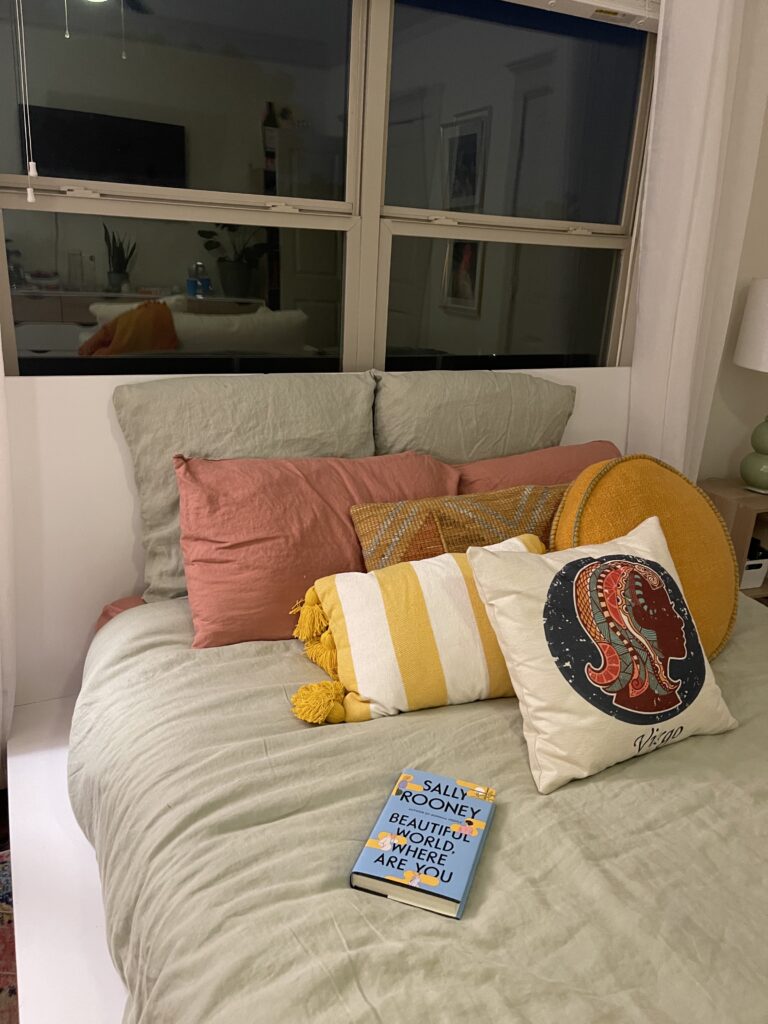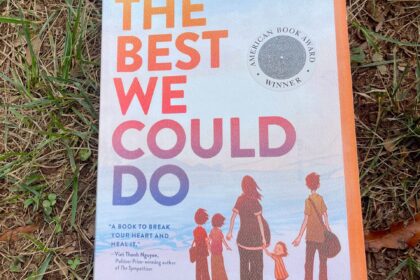My first five star read of the school year – and I am quite stingy with that prestigious accolade!
I have quite the humorous, self deprecating story of my coming to read the work of Sally Rooney, which I’ve described in more detail in a separate blog post. Just three months ago, in July, I, in all of my snobbery, looked down upon Sally Rooney fans. I scoffed at the bandwagon group I thought they were! I put them in the same category of people whose favorite show is The Office. Pick something more unique to like, dammit!
Now, in a humbling turn of events, I find myself a full blown Rooney-Toon.
And I promise I didn’t make that self-identifier up.
Sally Rooney, a 30 year old Irish Author, is being defined as the first great millennial novelist – the first author to write highly popular, profoundly powerful narratives about people in their twenties in our contemporary timeline. Sally Rooney continually provides answers to our most pressing question: what does it mean to be a person growing up while the rest of the world is collapsing?
Her first book, Conversations with Friends, dazzled the scene in 2017 with its sly, melancholy prose, the pull of austere glamour via Swiss vacation homes, promiscuous characters boasting elegant artistic careers, a subtle to nonexistent narrative voice presence, and the all too familiar millennial angst.
This was the novel that began my conversion. I knew that I would eventually have to admit my error of perception!
Her second book, Normal People, was released less than a year later (and was adapted into a wildly popular television series in 2020, available on Hulu). Normal People emerged as Rooney’s more mature second novel, exploring love across social classes and the effects of late capitalism with unmatched wit, humor, and nuance. The characters in Normal People were, to this date, Rooney’s best curated – authentic, three dimensional, flawed, and lovable.
I read Normal People as it demands to be read: in one sitting. After finishing it, I certainly knew that I had been wrong. I may not have been an ardent fan quite yet, but I could not dismiss her genius. There was a certain magnetism to her prose – something that kept me coming back. Something that lingered after I had put the book back on the shelf.
Something that lasted.
In January of 2021, Sally Rooney announced that her third novel, Beautiful World, Where Are You, would debut at the end of Summer. Brandon Taylor, author of Real Life and apparent head of the Sally Rooney fan club, immediately took to twitter:
“Rooney Toons, we ride again.”
See, I promise I didn’t make it up.
I pre-ordered it as soon as I could. And I read it in one week (which, considering I am a full time student also working 15-20 hours a week, is pretty fast for my personal school-year reading habits). I stayed up late reading, foregoing movie nights with my roommates and opting out of nights out with friends. I procrastinated my homework while reading. At one point, I was fully walking down Broad Street, in the rain, reading the book under the safety of my umbrella as I walked across a crosswalk.
I stole time to get through Beautiful World, carved time out of my all too busy life to spend with this text.
Why is that? Perhaps because of that special Sally Rooney magnetism.
Anyway. I’ll shut up now and get into the book.
Beautiful World, Where Are You centers around four conventionally unlikable, yet entirely believable, characters:
- Alice Kelleher: a wildly successful novelist, who, after publishing two best sellers, suffers a psychiatric breakdown. After being released from the hospital, Alice rents a cottage in a remote Irish coastal town where she knows no one. The price of authorial fame weighs on her constantly, and Alice is undoubtedly a stand in for Sally Rooney herself.
- Felix Brady: a local of the aforementioned remote town whom Alice meets through a dating app, who begrudgingly moves through life, treats women badly, and works at a local shipping warehouse.
- Eileen Lydon: a hyper-intellectual, ridiculously low paid editorial assistant at a Dublin Publishing House who has been Alice’s best friend since their days as college roommates, and happens to have quite the victim complex.
- Simon Costigan: a childhood friend of Eileen who works as a parliamentary assistant, has a career of becoming involved with much younger woman, and is devoutly Catholic.
So our cast of characters includes a pissed off celebrity, a grumpy blue collar worker, a victim complex, and a creepy Catholic. Quite the set up you got there, Rooney. Buckle up and get ready for the ride, Rooney Toons.
Beautiful World, Where Are You centers around the sexual and emotional entanglements of the two female best friends, Alice (with Felix) and Eileen (with Simon). The whole plot consists of these four protagonists desiring one another, deluding one another, getting together, and breaking apart – with the two women unpacking it all in long-winded, highly intellectual emails to one another. That’s it. That’s the plot.
In a New York Times Article, Brandon Taylor comments upon this apparent lack of plot:
“There is an argument to be made that “Beautiful World, Where Are You” is the kind of plotless un-novel we’re growing accustomed to. The characters banter about the uselessness of modern structures and our lack of faith in overriding narrative. While the techniques of modernism and postmodernism have been borrowed, assembled and arranged like items selected from an Ikea catalog, the contemporary un-novel has none of modernism’s or postmodernism’s desperate crisis of faith. That is, “Beautiful World, Where Are You” is carefully formless and its characters are fluent in our lingua franca of systemic collapse, that neoliberal patter of learned helplessness in the face of larger capital and labor systems.”
The form of this novel is much more structurally complex than her previous work. After one chapter of traditional narrative action, an email appears (alternatively written by either Alice or Eileen) and takes center stage for a chapter – alternating in form throughout the entirety of the book. The emails serve as anchors for the narrative structure of the plot (literary scholars would call this an epistolary form, but that’s an unimportant vocabulary word).
The interspersed email chapters ground the reader within these two geographically disparate narratives, arguing that perhaps, they are not disparate at all.
The stories are connected precisely because Alice and Eileen choose to share them with one another – as if to say that perhaps this is how we form connection in our ever-decaying world.
Sally Rooney’s style remains precise and clean, piercing and honest. As a reader, I enjoyed watching her experiment with new narrative techniques: omniscient, distant third person narration, epistolary forms, and close first person narration through the emails. Her flexibility as an author was on full display in Beautiful World, and I believe she’s beginning to play with some narrative techniques that will only grow more refined as she matures as an author.
Beautiful World, Where Are You, at its core, asks its readers how we are to exist, love, and find beauty in a world so hell bent on systemic collapse? What is the point of loving at all if the world is going to shit?
Hell if I know.
But to this question, Rooney answers that beauty, love, and art are quite literally the only things we can do in the face of destruction.
We must seek and create the beauty in the world, we must enact agency in rendering the world beautiful.
Centered around mildly annoying, economically well-off characters frequently making questionable (and sometimes downright terrible) decisions while navigating love, loss, mental health, sexuality, and identity, Sally Rooney’s Beautiful World, Where Are You does for 2021 what Jane Austen’s Emma did for 1815.
As a Jane Austen fanatic, perhaps this is why I loved this text so much. It felt familiar, it felt like Emma, but written for me – a 21 year old woman navigating a world hell bent on destroying itself.
Excellent in language, form, dialogue, and style, this novel had me in wrapped around its finger from beginning to end.
Some of my favorite quotes:
“And I want that – to prove that the most ordinary thing about human beings is not violence or greed but love and care.”
“Most of our attempts throughout human history to describe right and wrong have been feeble and cruel and unjust, but that difference still remains – beyond ourselves, beyond each specific culture, beyond every individual person who has lived or died. And we spend our lives trying to know that difference and live by it, trying to love other people instead of hating them, and there is nothing else that matters on this earth.”
“And were they aware, in the intensity of their embrace, of something slightly ridiculous about this tableau, something almost comical, as someone nearby sneezed violently into a crumpled tissue;… as life in its ordinariness and even ugly vulgarity imposed itself everywhere all around them? Or, were they in this moment unaware, or something more than unaware – were they somehow invulnerable to, untouched by, vulgarity and ugliness, glancing for a moment into something deeper, something concealed beneath the surface of life, not unreality but a hidden reality: the presence at all times, in all places, of a beautiful world.”
I will be searching for that hidden reality for a long long time, forever, I hope. May we never forget that there is indeed a beautiful world, but we have to consistently ask the question and ceaselessly follow where the answers lead us: Beautiful World, Where Are You?





